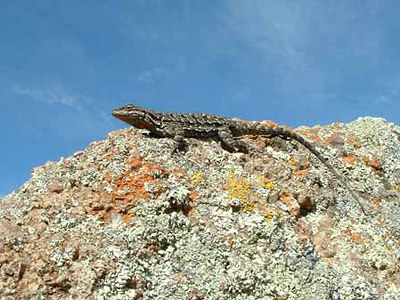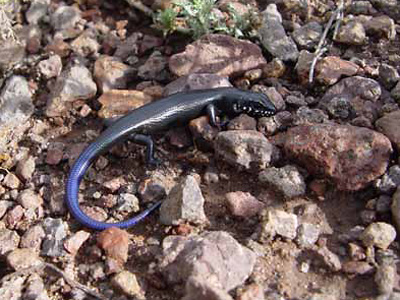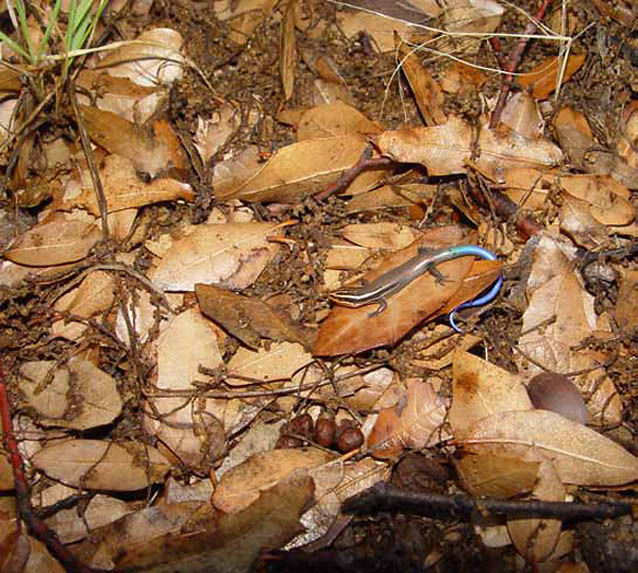Fort Davis National Historic Site (NHS) is located in the highly diverse Davis Mountains in southwestern Texas and is small enough that the researchers and a park partner were able to survey most of the site.
The majority of the search was focused on Hospital Canyon, the flats surrounding and north of the fort ruins, and the trail system. The inventory took place from May to August 2003 and June to September 2004.
Methods

Dave Prival
Several search approaches were implemented to find reptiles and amphibians: foot surveys, incidental observations, and pitfall traps. Different approaches were used each year (2003 and 2004) to maximize the likelihood of finding different species. For each reptile or amphibian observed, location, time, weather, and species were recorded.
Foot surveys were conducted at times when reptiles and amphibians were most likely to be active (morning around sunrise and evening around sunset). Most of the foot surveys were conducted off-trail. While on foot, searches included looking under rocks and logs, and mirrors and flashlights were used to illuminate crevices. Incidental observations were recorded while the researchers were not conducting formal searches (e.g., on days off or while driving to a search area). Pitfall traps were used to capture small reptiles and amphibians running or crawling across the ground. In 2003, two sets of pitfall traps were checked by Fort Davis NHS staff and volunteers daily.
Voucher specimens were collected for nearly each species found in Fort Davis NHS. Voucher specimens provide proof that the species actually occurred in Fort Davis NHS during the inventory and help to confirm it was correctly identified in the field. These specimens provide important data about reproduction, diet, health, and morphology. DNA collected from voucher specimens can be used to examine population questions and genetic relationships within and between species. For this inventory, the voucher specimens from Fort Davis NHS are on permanent loan to and stored at the Museum of Southwestern Biology, University of New Mexico, Albuquerque, and are freely available to researchers and managers.
Results

Ian Murray
In total, 1,161 reptiles and amphibians were found at Fort Davis NHS during this inventory, representing 29 species: five frogs and toads, 12 lizards, 11 snakes, and one turtle. The majority of observations were recorded during foot surveys: 882 animals of 25 species. Incidental observations accounted for 318 animals of 23 species and 21 animals of nine species were caught in pitfall traps. A total of 29 voucher specimens comprising 27 species were collected.
One species found in Fort Davis NHS was listed as state threatened, the Texas horned lizard (Phrynosoma cornutum). No non-native reptile or amphibian species were found during this inventory.
Discussion
Fort Davis NHS is a small site located in the highly diverse Davis Mountains. Consequently, it is likely that many species occur occasionally at the site that were not documented in the survey. In order to determine what percentage of the actual total herpetofauna community was documented in this inventory, the results were compared to lists of species likely to occur in Fort Davis NHS based on range maps and available habitat. It is estimated that there were probably 22 species that are likely to occur in the park, at least occasionally, that were not observed (four frogs and toads, one salamander, five lizards, 11 snakes, and one turtle), meaning this inventory may have documented 57% of the reptile and amphibian species in Fort Davis NHS. However, the lack of previous intensive surveys gives little confidence in the total estimate of species that occur in the park. Repeat surveys may be warranted.

Ian Murray
This inventory can be used as baseline data for future monitoring. Long-term monitoring and/or repeated inventories may help detect changes within reptile and amphibian communities caused by climate change, drought, invasion by non-native species, wildland fire, or other factors. Reptile and amphibian populations can change dramatically between surveys in a given year due to the timing and amounts of precipitation. Future monitoring or inventories should survey each area multiple times in a season.
See Chapter 7 (Literature Cited and Project Contacts) for a link to the full report including a list of species found during this inventory.
Part of a series of articles titled Chihuahuan Desert Network Reptile and Amphibian Inventories.
Last updated: January 4, 2017
